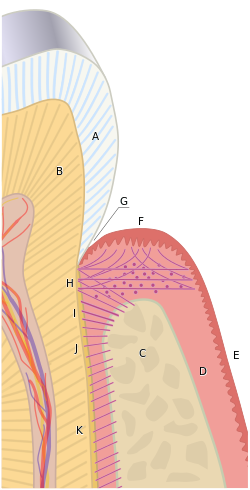
Back دواعم الأسنان Arabic Periodonci Catalan Zahnhalteapparat German Periodonto Spanish Parodont Estonian Periodonto Basque پیرادندان Persian Parodontium Finnish Parodonte French Fogágy Hungarian
| Periodontium | |
|---|---|
 The tissues of the periodontium combine to form an active, dynamic group of tissues. The alveolar bone (C) is surrounded for the most part by the subepithelial connective tissue of the gingiva, which in turn is covered by the various characteristic gingival epithelia. The cementum overlaying the tooth root is attached to the adjacent cortical surface of the alveolar bone by the alveolar crest (I), horizontal (J) and oblique (K) fibers of the periodontal ligament. | |
| Details | |
| Identifiers | |
| Latin | periodontium |
| MeSH | D010519 |
| TA98 | A05.1.03.058 A03.1.03.002 |
| TA2 | 2819 |
| Anatomical terminology | |
The periodontium (from Greek περί (peri-) 'around' and -odont 'tooth') is the specialized tissues that both surround and support the teeth, maintaining them in the maxillary and mandibular bones. Periodontics is the dental specialty that relates specifically to the care and maintenance of these tissues. It provides the support necessary to maintain teeth in function. It consists of four principal components, namely:[1]
- Gingiva (the gums)
- Periodontal ligament (PDL)
- Cementum
- Alveolar bone proper
Each of these components is distinct in location, architecture, and biochemical properties, which adapt during the life of the structure. For example, as teeth respond to forces or migrate medially, bone resorbs on the pressure side and is added on the tension side. Cementum similarly adapts to wear on the occlusal surfaces of the teeth by apical deposition. The periodontal ligament in itself is an area of high turnover that allows the tooth not only to be suspended in the alveolar bone but also to respond to the forces. Thus, although seemingly static and having functions of their own, all of these components function as a single unit.[2] The Wnt signaling antagonist Sfrp3/Frzb has been recently discovered as an early developmental marker of the periodontium.[3]
- ^ Kumar GS, ed. (2011). "8". Orban's Oral Histology and Embryology (13th ed.). New Delhi: Elsevier. p. 172. ISBN 9788131228197. Retrieved 22 April 2016.
- ^ Newman MG, Takei H, Klokkevold PR, Carranza FA, eds. (2012). Carranza's Clinical Periodontology (11th ed.). St. Louis, MO: Saunders Elsevier. ISBN 9781455706389. Retrieved 22 April 2016.
- ^ Mitsiadis TA, Pagella P, Cantù C (2017). "Early Determination of the Periodontal Domain by the Wnt-Antagonist Frzb/Sfrp3". Frontiers in Physiology. 8: 936. doi:10.3389/fphys.2017.00936. PMC 5702314. PMID 29209231.